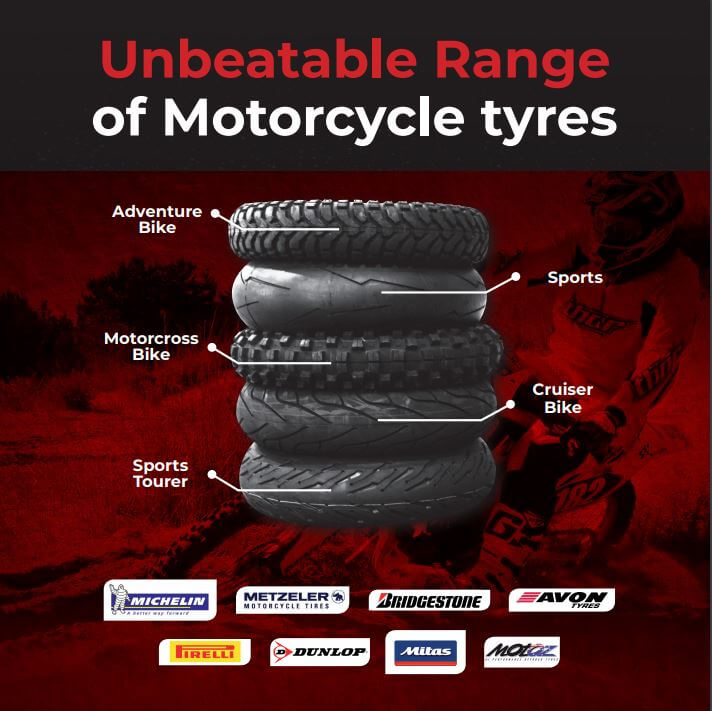Motorcycle Tyre Questions: Motorcycle Tyre Lifespan, Replacement, and Maintenance

Motorcycle Tyre Questions: Demystifying Motorcycle Tyre Lifespan, Replacement, and Maintenance
Motorcycle enthusiasts often have questions about their motorcycle tyres, and rightfully so. Motorcycle tyres are a critical component of your bike’s safety and performance. To address some common queries, let’s explore key questions riders often ask about their motorcycle tyres.
1. What is the Lifespan of a Motorcycle Tyre?
The lifespan of a motorcycle tyre varies depending on several factors, including the type of tyre, your riding style, and maintenance. In general, most motorcycle tyres can last anywhere from 5,000 to 15,000 miles. Sport and sport-touring tyres may wear out faster due to their softer rubber compounds, while cruiser tires tend to last longer.
To maximize the lifespan of your motorcycle tyres, maintain proper tyre pressure, perform regular tyre inspections, and ride within your bike’s weight and load capacity limits.
2. How Do I Prevent My Motorcycle Tyres from Squaring Off?
Squaring off, or flat-spotting, is a common issue, particularly with rear motorcycle tyres. It occurs when the center of the tyre wears down faster than the sides, leading to a flat spot. To prevent this:
- Ride Aggressively: Try to lean your bike into turns more, evenly distributing wear across the tyre.
- Proper Tyre Pressure: Maintain recommended tyre pressure. Underinflated tyres can cause uneven wear.
- Regular Tyre Inspections: Check your tyres for signs of squaring off. If you notice it early, you may be able to adjust your riding habits to mitigate further damage.
3. How Much Does it Cost to Replace a Motorcycle Tyre?
The cost of replacing a motorcycle tyre can vary widely based on several factors:
- Tyre Brand and Model: Premium brands may be more expensive than budget options.
- Tyre Size: Larger and more specialized tyres tend to cost more.
- Installation: If you have the tyre professionally installed, this will add to the cost.
- Additional Services: If you need wheel balancing or an alignment, expect additional charges.
On average, you can expect to pay anywhere from $100 to $500 per tire, but this can be higher for certain brands or models.
4. At What Age Should Motorcycle Tyres be Replaced?
Tyre age is an important consideration. Even if your tyres have plenty of tread left, they can degrade over time. Most tyre manufacturers recommend replacing motorcycle tyres that are over five years old, regardless of tread depth. This is because the rubber compound can harden and lose grip, making the tyre less safe, especially in wet conditions.
Check the manufacturing date on your tyres’ sidewall (look for a four-digit code). If they’re approaching five years, consider replacement.
5. Do Motorcycle Tyres Wear Out Faster?
Motorcycle tyres do tend to wear out faster than car tyres. Several factors contribute to this:
- Smaller Contact Patch: Motorcycles have a much smaller tyre contact patch with the road compared to cars, so the load is concentrated on a smaller area.
- Riding Style: Aggressive riding, such as frequent acceleration, braking, and hard cornering, can accelerate tyre wear.
- Softer Compounds: High-performance motorcycle tyres often have softer rubber compounds for better grip, but this results in faster wear.
To extend the life of your motorcycle tyres, ride responsibly, maintain proper tyre pressure, and perform regular inspections.
6. How Do You Break in a Motorcycle Tyre?
Breaking in a new motorcycle tyre is essential for optimal performance and safety. To break in a tyre:
- Start Slowly: For the first 100 miles or so, take it easy. Avoid hard acceleration, aggressive braking, and sharp cornering.
- Gradually Increase Pace: After the initial break-in period, gradually increase your speed and lean angle. This allows the tyre to adapt to the road surface and reach its optimal grip level.
Properly breaking in your tyres ensures that they provide maximum traction and stability when you need it most.
7. Will Flat Spots on Motorcycle Tyres Go Away?
Flat spots on motorcycle tyres can be a concern, especially if your bike has been stored for an extended period. In many cases, these flat spots can go away on their own as you ride and the tire warms up. However, severe flat spots may not fully recover, affecting ride quality and safety.
To prevent flat spots during storage, use a paddock stand to lift the tyres off the ground or roll the bike occasionally to redistribute the weight on the tyres.
In summary, motorcycle tyre maintenance and care are essential for safety and performance. Understanding the factors affecting tyre lifespan, preventing squaring off, and knowing when to replace tyres based on age and wear are crucial for every rider. Additionally, proper break-in procedures and tyre maintenance practices can enhance your riding experience and ensure you get the most out of your motorcycle tyres.
































